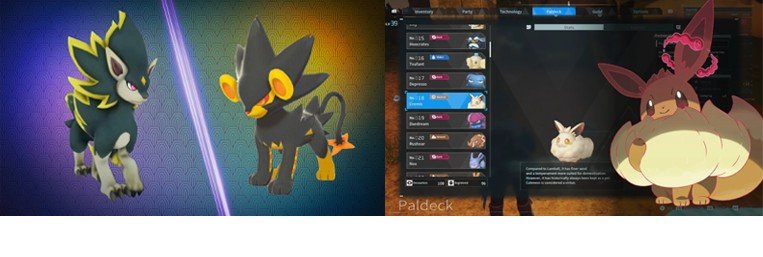Pikachu with guns? Nintendo fires back
31 January 2025
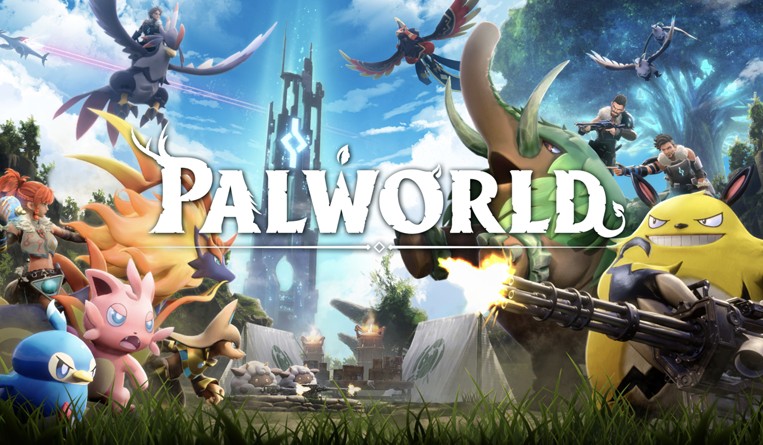
Source: Palworld, via Steam
A new game imagines Pokémon-like creatures thrust into a dystopian landscape where they build factories and wield firearms. Nintendo has filed suit in Tokyo District Court against Palworld, claiming it infringes patents behind its US$100 billion Pokémon franchise. - Cathy Li reports
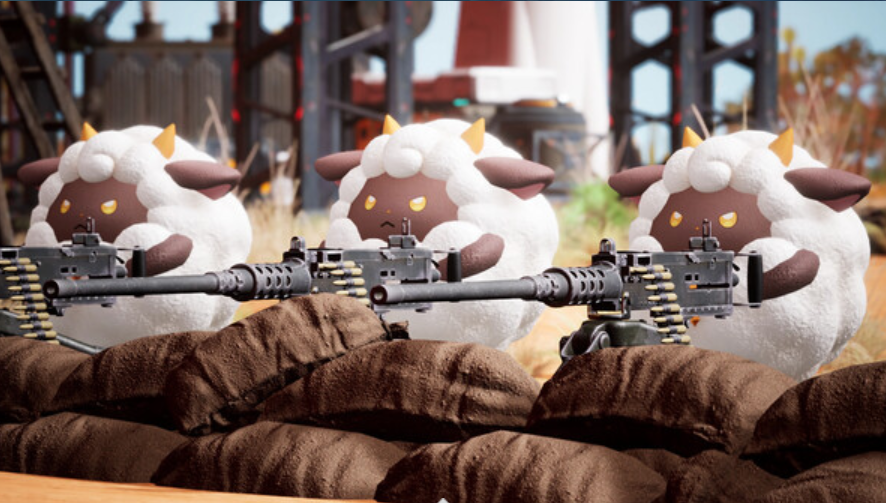
Source: Palworld, via Steam
Your beloved, colourful Pokémon-like creatures, once confined to playful battles, now wielding firearms, building factories and even being sacrificed in the name of survival. Welcome to Palworld, a chaotic, dystopian playground where pals are more than just companions – they’re labourers, warriors and tools for a brutal, unforgiving world.
Imagine a game where every corner reveals a new twist, green forests suddenly darkened by the thrum of industrial machinery, creatures that once seemed innocent now caught in the crossfire of warfare. This daring combination of charm and violence has captured the imagination of gamers and sparked fierce debate. But it has also caught the attention of Nintendo, which claims that Palworld has borrowed too much from its Pokémon franchise, including key gameplay mechanics like the iconic creature-capture system and mounting system. As Palworld continues to blur the lines between innocence and brutality, its fate now rests in the hands of a Tokyo courtroom, where Nintendo is challenging its creators over patent infringement.
At the heart of the dispute is Nintendo’s assertion that Palworld infringes on patented gameplay mechanics integral to its US$100 billion Pokémon franchise. Pocketpair, on the other hand, argues that its darker, ethically complex gameplay – and Pocketpair’s claim to creative evolution, offering darker, ethically charged gameplay where cuddly creatures double as factory workers or gun-wielding allies in combat – represents a bold reimagining of the genre.
According to statements released by the parties, Nintendo and The Pokémon Company have sued Pocketpair in Tokyo District Court, seeking both an injunction and compensation for patent infringement on the grounds that Palworld infringes multiple patent rights. The Pocketpair statement adds that Nintendo and The Pokéman Company are each seeking ¥5 million (US$32,000) plus late payment damages from Pocketpair.
Despite Nintendo’s legal action against Palworld, indie studio Pocketpair is pressing ahead with the success of its monster-filled survival game, announcing an exciting new expansion, Feybreak, which launched in late December.
Heart of the dispute
At first glance, Palworld is known to the public as “Pokémon with guns,” since many of its creatures resemble those from Pokémon, but with a unique twist. However, Nintendo did not sue over the design patents of its characters, but rather over patents related to specific game mechanics.
Both games share a foundation in the “monster-collection” and “mounting” genre, with both Pokémon and Palworld involving capturing creatures using a ball-like object and featuring mechanics where players can ride their captured creatures. While Pokémon arguably popularized the genre, it didn’t invent it. Titles like Dragon Quest V (1992) and Shin Megami Tensei (1992) also featured creature-collecting mechanics before Pokémon debuted in 1996.
“Sure, some might call this game a Pokémon knockoff, but I’d say it’s more like the glow-up Pokémon never knew it needed!” said Krex, a player commenting about Palworld on Steam, an online game platform. “This game takes everything I have been wishing for and delivers it with style, filling the gaps where Pokémon’s been playing safe.” On the other hand, part of the player base says they play it because it has connections to Pokémon and allows them to do things they can't do in Pokémon.
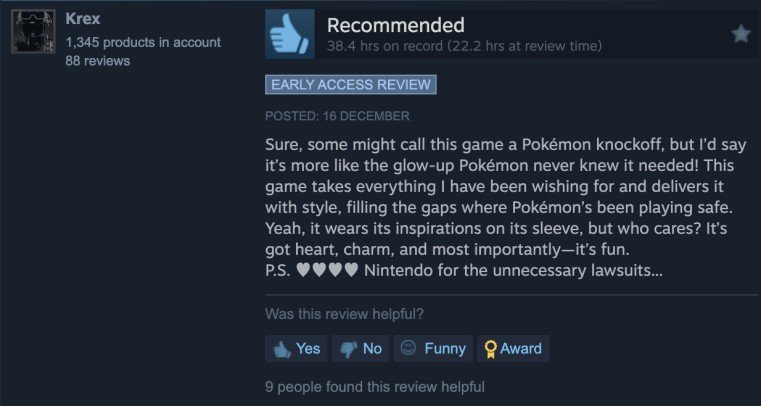
Palworld Game Review, via Steam
Pocketpair’s Palworld innovates on the genre in ways that may distance it from Pokémon. Unlike the family-friendly themes of Nintendo’s franchise, Palworld introduces ethically complex gameplay elements, such as using creatures for industrial labour or combat scenarios involving firearms. This tonal and thematic divergence could support Pocketpair’s argument that Palworld represents a creative evolution rather than a derivative work.
“However, once you get past the pal designs and capture mechanic, it’s not like Pokémon at all, it’s Ark and Zelda,” comments a player on Palworld’s Steam forum.
This raises a question in the ongoing intellectual property debate: could Palworld's similarities to Pokémon confuse customers into thinking it’s part of that franchise?
Legal experts point out that determining whether such confusion exists, it depends on factors like the customer’s prior familiarity with Pokémon. Courts must evaluate confusion as a factual matter, considering surrounding circumstances, and while anecdotal evidence, such as forum comments, can be influential, it may not be definitive in determining whether the public is misled.

“Whether there is such leveraging would depend on, amongst other things, whether customers are ‘confused’ and/or mistaken as to Palworld being a part of the Pokémon franchise. This is a key, yet difficult, question to answer because it is impacted by a whole host of other factors including, whether that individual was already familiar with the Pokémon franchise and the extent of that familiarity,” said Meryl Koh, a director at Drew & Napier in Singapore. She explains that confusion is a factual inquiry to be undertaken by the court in light of surrounding circumstances. This means that anecdotal evidence can be used, though not necessarily definitive by parties to prove the relevant public was or was not confused.
Infringement or creative evolution?
The legal question lies less in thematic originality and more in the technical execution of gameplay. If Palworld employs systems that mirror patented elements of Pokémon – such as the mechanics for capturing creatures or their role in battles – these similarities could outweigh broader creative differences.
The complexity of Nintendo’s claims lies in determining whether these mechanics, while seemingly similar, cross the line into patent infringement. The divisional patents filed by Nintendo (JP7545191, JP7493117, and JP7528390) were issued well after the release of Palworld, leading to questions about the timing and whether these claims represent a legitimate application of Nintendo’s intellectual property. All of these patents were applied for between February and July of 2024 and registered between May and August. Notably, all of these applications came after the release of Palworld, which launched in early access on January 19, 2024.
The core issue is whether Palworld’s creature mechanics are “substantially similar” to the systems protected under Nintendo’s patents. The patents in question cover specific technical details such as how creatures are summoned, how they interact within the game environment, and the mechanics for mounting and using creatures in gameplay scenarios.
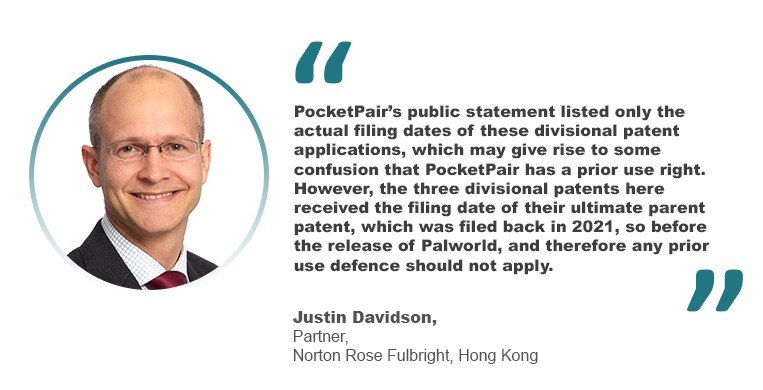
“Pocketpair’s public statement listed only the actual filing dates of these divisional patent applications, which may give rise to some confusion that Pocketpair has a prior use right,” said Justin Davidson, a Hong Kong-based partner at Norton Rose Fulbright who heads the firm’s Asia intellectual property team.
This right allows for the continued production of a product or use of a process that is later patented, provided that the initial manufacture or use occurred before the patent's filing date – or priority date, if applicable.
“However, the three divisional patents here received the filing date of their ultimate parent patent, which was filed back in 2021, so before the release of Palworld, and therefore any prior use defence should not apply,” said Davidson.
While the current legal battle between Nintendo and Pocketpair primarily focuses on patent infringement, there are other legal frameworks that could potentially be leveraged in this dispute. One such avenue is the doctrine of trade dress, which protects the visual appearance and design of a product that signifies its source to consumers.
Trade dress encompasses the overall look and feel of a product, including its shape, colour, and design elements. In the context of Palworld and Pokémon, this could involve the distinctive appearance of the creatures and the game’s interface. However, establishing trade dress protection can be challenging, as it requires proving that the design is inherently distinctive and serves as a unique identifier of the product.
In Japan, trade dress can be protected under the Japanese Trademark Act and the Unfair Competition Prevention Law. However, the criteria for protection are stringent, requiring the trade dress to be non-functional and to have acquired secondary meaning among consumers. This means that the design must be recognized by the public as being associated with a particular source.
“The biggest hurdle in a case like this, assuming a claimant has registered a trade dress in Japan, is that it is not always easy to prove that the appearance of claimant’s game is so inherently distinctive as to be worthy of exclusive protection. For example, it remains to be seen how one can prove that fantasy characters based off real-life animals are so inherently distinctive so as to be given trade dress protection,” said Koh.
Legal challenges and market implications
As the legal dispute between Nintendo, The Pokémon Company, and Palworld developer Pocketpair continues, the game has undergone significant updates to its creature summoning mechanics.
Prior to the November 29, 2024, patch 0.3.11, Palworld featured a mechanic where players could throw a Pal Sphere onto the battlefield to summon their Pal, a system reminiscent of Pokémon’s Poké Ball mechanics. This similarity raised concerns about potential patent infringement.
Following the latest update to Palworld, the game’s summoning mechanic has been altered: instead of throwing a Pal Sphere to summon a creature, players will now see their Pal appear immediately next to their character. While some have speculated that this change is linked to the ongoing legal challenges involving Nintendo’s Pokémon franchise, there has been no official statement confirming this connection.
In addition to the mechanic overhaul, the update introduces several new features, including new pals, weapons, and architectural styles for town building. One of the most significant additions is a vast new island, described by Pocketpair as being approximately six times the size of the previously added Sakurajima island. Players will be able to explore this expansive area, catch new pals, and face off against a new faction leader in a boss fight.
Looking ahead, Pocketpair is preparing for the release of another Palworld update, titled Feybreak, which was announced at the 2024 Game Awards. The update, set to launch on December 23, will feature new content, including a new faction leader and a variety of new weapons, showcased in a 92-second cinematic trailer. As with previous updates, it is expected that the patch will first launch on PC before becoming available on consoles.
Traditionally, gaming disputes have predominantly centred around copyright issues, often involving claims related to art assets, storylines, and character design, along with potential trade dress or unfair competition concerns. In these cases, the gameplay mechanics themselves were often overlooked since they can only be protected under patent law, a domain traditionally not often used in the gaming industry. However, as the market for video games continues to grow exponentially, disputes are increasingly extending into the realm of gameplay mechanics and patent law.
“Since copyright does not protect gameplay mechanisms, in this case Nintendo is seeking to enforce on the basis of its patent rights, which is a far less frequent enforcement tool in the gaming industry,” said Stanley Ng, a lawyer at Norton Rose Fulbright in Hong Kong.
One of the most notable examples of this shift is the Tetris Holding, LLC v. Xio Interactive, Inc. case, which became a landmark in video game cloning litigation. In this case, the developers of the iconic puzzle game Tetris sought to protect not only its visual assets but also its core gameplay mechanics, arguing that the game’s unique design and playstyle constituted intellectual property that deserved patent protection. The case, which revolved around the alleged copying of Tetris by a mobile game app, brought attention to the growing significance of patents in the gaming world. While copyright remains the primary form of protection for many video games – especially those that rely on creative visual and narrative content – there has been an increasing recognition of the importance of patent law in safeguarding innovative gameplay mechanics.
It is estimated that the global gaming market will amount to US$503.14 billion annually in 2025, up from US$396 billion in 2023. Asia Pacific is set to remain the top-grossing gaming market worldwide, according to Statista.
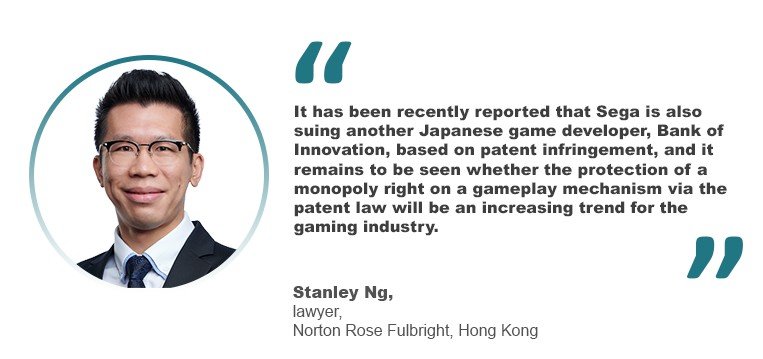
“It has been recently reported that Sega is also suing another Japanese game developer, Bank of Innovation, based on patent infringement, and it remains to be seen whether the protection of a monopoly right on a gameplay mechanism via the patent law will be an increasing trend for the gaming industry,” said Ng. In the gaming industry, technological advancements have led to more patents for game mechanics, hardware, and algorithms.
As gaming companies increasingly seek to protect unique gameplay mechanics, this case could set a precedent for how intellectual property law is applied to the evolving mechanics of video games. More companies are now exploring patent rights not only for visual assets but for core game functions.



